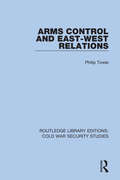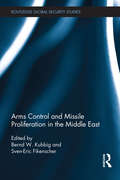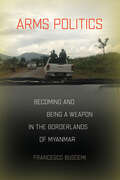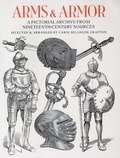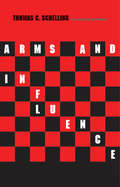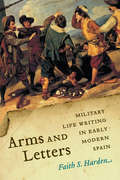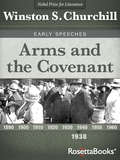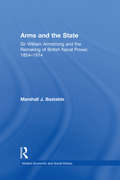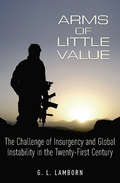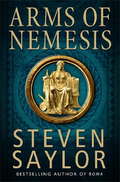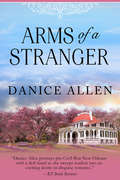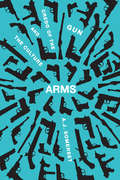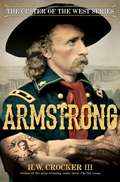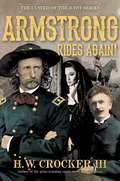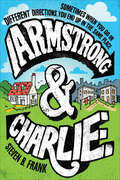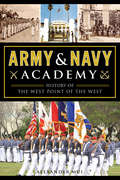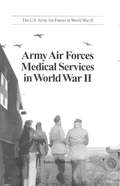- Table View
- List View
Arms Control Agreements: A Handbook (Routledge Library Editions: Cold War Security Studies #5)
by Jozef GoldblatThis book, first published in 1982, provides a well-informed historical overview, insightful analysis and searching critique of arms control agreements and negotiations from the Hague Declaration of 1899 to the SALT Treaties and Conventions of the 1970s and 1980s. Arms control agreements of international importance and historical merit are assessed, for the extent to which each affected the arms race or reduced the likelihood of war.
Arms Control and East-West Relations (Routledge Library Editions: Cold War Security Studies #4)
by Philip TowleThis book, first published in 1983, examines the role that arms control has to play, alongside defence and deterrence, in stabilising East-West relations and reducing tensions during the Cold War. Arms control agreements were designed in the attempt to achieve parity between the nuclear forces of the superpowers, without making war more likely. A danger of confrontation between the USSR and the USA came from their involvement in Third World conflicts, and this arena is also discussed. The diplomatic approaches of the Soviet Union, the Third World and the West, and their aims in arms control, are also analysed.
Arms Control and Missile Proliferation in the Middle East (Routledge Global Security Studies)
by Bernd W. Kubbig Sven-Eric FikenscherThis edited volume provides a systematic analysis of the missile threat and proliferation issue in the Middle East region. The question of how to increase the level of security in the Middle East is not a new one, given the conflict-ridden nature of the region. The solution attempted for this predicament has typically revolved around intense arms build-ups, a strategy which can prove self-defeating due to the subsequent countermeasures employed by neighbouring states. Arms Control and Missile Proliferation in the Middle East focuses on the strategic proliferation of arms, with a specific emphasis on missiles. This unique emphasis enables the contributors to provide a dynamic new perspective on conceptual and political disarmament efforts, thereby distinguishing this volume from many other related works on the region, which deal mainly with weapons of mass destruction. The book also explores the possibility of a reduction in weapon arsenals, examining a more promising cooperative security concept which includes confidence- and security-building measures (CSBMs). This book will be of much interest to students of arms control, Middle Eastern politics, Gulf Security, war and conflict studies, security studies and IR.
Arms Control: New Approaches to Theory and Policy
by Nancy W. GallagherContents: Bridging the Gaps on Arms Control Nancy W. Gallagher. Arms Control in the Information Age Emily O. Goldman. A New Role for Transparency Ann M. Florini. Beyond Deterrence, Defence, and Arms Control Gloria Duffy. Nuclear Arms Control through Multilateral Negotiations Rebecca Johnson. The Impact of Govermental Context on Negotiation and Implementation: Constraints and Opportunities for Change Amy Sands. The Politics of Verification: Why How Much?' is Not Enough Nancy W. Gallagher.
Arms Politics: Becoming and Being a Weapon in the Borderlands of Myanmar
by Francesco BuscemiIn Arms Politics, Francesco Buscemi tells the story of the ceasefire, disarmament, and rearmament of the Ta'ang movement in Myanmar's Shan State through an analysis of the formation of the Palaung State Liberation Front/Ta'ang National Liberation Army (PSLF/TNLA). With a focus on the circulation of weapons through the post-1991 ceasefire, disarmament, and rearmament years, Buscemi explores how "becoming and being" an armed force leads to the "becoming and being" of a rebel polity.Buscemi argues that the governance of arms and weaponry by rebel movements such as the PSLF/TNLA shapes historically and spatially complex relationships among leadership, rank-and-file, civilians, and civil society groups. Furthermore, he demonstrates that it is through the acquisition of weapons and the governing of armed collectives that rebel movements reproduce and shape the collective identity of their polity and its political geography. Against the backdrop of the world's longest ongoing armed conflict, Arms Politics shows how the processes and practices of governing weapons shape social and spatial relations of rule at the edges of state authority.
Arms Transfers and Dependence (Routledge Revivals)
by Christian CatrinaFirst published in 1988, Arms Transfers and Dependence was written to provide a view of arms transfers in the context of the global distribution of power. The book analyses different types of dependence and is focused on comparing the enhancement of military capabilities as a result of arms transfers with the dependence that may be caused by those transfers. In doing so, it provides an overview of how particular structures of imports and exports of arms lead to dependence.
Arms and Armor of the Medieval Knight
by John Miles David EdgeTraces changes in armor and weaponry as the knight's rol in warfare and peacetime society changes from the Middle Ages through the 15th century. Book includes detailed descriptions and pictures of armor and weaponry worn during this long time span. The author explains how armor and weapons are influenced and changed.
Arms and Armor: A Pictorial Archive from Nineteenth-Century Sources (Dover Pictorial Archive)
by Carol Belanger GraftonOver thousands of years, man has developed an enormous variety of offensive and defensive weapons for use in battle as well as a vast array of armor and other protective devices. Now artists and illustrators can draw on this extensive archive for superb copyright-free illustrations of vintage arms, armor, and other battlefield paraphernalia. Choose from a rich trove of over 750 illustrations compiled from rare nineteenth-century sources. Included are detailed, high-quality depictions — arranged chronologically and, to some extent, geographically — of suits of armor, chain mail, swords, halberds, spears, pikes, lances, crossbows, axes, daggers, helmets, shields, knives, small arms, and a host of other implements, along with scenes of battle, siege, jousts, soldiers, horses, and more. Especially suitable for projects requiring a medieval or old-fashioned flavor, these illustrations reproduce extremely well. They will fill a myriad of needs for battle-related graphic art.
Arms and Armour of the Imperial Roman Soldier: From Marius to Commodus, 112 BC–AD 192
by Raffaele D'Amato Graham SumnerA survey of the various forms of armour worn by the Roman soldier from 112 BC to 192 AD, featuring a wealth of illustrations and plates. From the Latin warriors on the Palatine Hill in the age of Romulus, to the last defenders of Constantinople in 1453 AD, the weaponry of the Roman Army was constantly evolving. Through glory and defeat, the Roman warrior adapted to the changing face of warfare. Due to the immense size of the Roman Empire, which reached from the British Isles to the Arabian Gulf, the equipment of the Roman soldier varied greatly from region to region. Through the use of materials such as leather, linen and felt, the army was able to adjust its equipment to these varied climates. Arms and Armour of the Imperial Roman Soldier sheds new light on the many different types of armour used by the Roman soldier, and combines written and artistic sources with the analysis of old and new archaeological finds. With a huge wealth of plates and illustrations, which include ancient paintings, mosaics, sculptures and coin depictions, this book gives the reader an unparalleled visual record of this fascinating period of military history. This book, the first of three volumes, examines the period from Marius to Commodus. Volume II will cover the period from Commodus to Justinian, and Volume III will look at the period from Romulus to Marius. &“An impressive achievement, a testament to an enormous scholarly effort—and it is a significant contribution to the understanding of the Roman army.&” —Bryn Mawr Classical Review &“Without doubt, this is the definitive study of clothing, armour and weaponry worn by Roman soldiers during the golden age of their conquests...D&’Amato has brought together a remarkable collection of archaeological photographs gathered over decades to illustrate every aspect of this military evolution . . . A treasure trove of facts and illustrations that is essential reading for any Roman military enthusiast.&” —Tim Newark, Military Illustrated Magazine
Arms and Equipment of the Civil War (Civil War)
by Jack CogginsThe first military conflict to use iron-clad gunboats, metallic cartridges, and submarines, the Civil War also introduced such inventions as the telegraph and military balloon, utilized by the Signal Corps. This comprehensive reference brings a fresh perspective to wartime victories and defeats, with vivid descriptions of how the war was fought and what materiel was available to armies and navies of the Union and the Confederacy. Profusely illustrated with hundreds of the author's own drawings, Jack Coggins's remarkable encyclopedia of military hardware and technology also describes such equipment as pontoon bridges, corduroy roads, "excelsior" percussion grenades, "freak guns," siege artillery, mines, and submarine torpedoes. Offering a new view on how military resources decided the outcome not only of battles, but of the war as well, the text also includes on-the-scene comments by Union and Confederate soldiers about equipment and camp life in general. A must-have book for every Civil War enthusiast and for readers interested in the development of weaponry.
Arms and Influence
by Prof. Thomas C. SchellingThe author concentrates in this book n the way in which military capabilities real or imagined are used, skillfully of clumsily, as bargaining power. He sees the steps taken by the U. S. during the Berlin and Cuban crises as not merely preparations for engagement, but as signals to and enemy, with reports from the adversary's own military intelligence as our most important diplomatic communications.
Arms and Influence (Veritas Paperbacks)
by Thomas C. Schelling&“This is a brilliant and hardheaded book. It will frighten those who prefer not to dwell on the unthinkable and infuriate those who have taken refuge in stereotypes and moral attitudinizing.&”—Gordon A. Craig, New York Times Book Review Originally published more than fifty years ago, this landmark book explores the ways in which military capabilities—real or imagined—are used, skillfully or clumsily, as bargaining power. Anne-Marie Slaughter&’s new introduction to the work shows how Schelling&’s framework—conceived of in a time of superpowers and mutually assured destruction—still applies to our multipolar world, where wars are fought as much online as on the ground.
Arms and Letters: Military Life Writing in Early Modern Spain (Toronto Iberic)
by Faith S. HardenArms and Letters analyses the unprecedented number of autobiographical accounts written by Spanish soldiers during the sixteenth and seventeenth centuries. These first-person retrospective works recount a range of experiences throughout the sprawling domain of the Hispanic monarchy. Reading a selection of autobiographies in contemporary historical context – including the coalescing of the first modern armies, which were partially populated by forced recruits and the urban poor – Faith S. Harden explains how soldiers adapted the concept of honour and contributed to the burgeoning autobiographical form. Harden argues that Spanish military life writing took two broad forms: the first as a petition, wherein the soldier’s service was presented as a debt of honour, and second, as a series of misadventures, staging honour as a spectacle that captivated an audience. Honour was inevitably gendered and performative, and as such, it functioned as one of the overarching metrics of value that early modern men and women applied to themselves and others. In charting how non-elite subjects rendered their lives legitimate through autobiography, Arms and Letters contributes both to a critical genealogy of honour and to the history of life writing.
Arms and the Covenant (Winston S. Churchill Early Speeches)
by Winston S. ChurchillThis inspiring collection of campaign speeches from the British prime minister bring his oratory brilliance and powers of persuasion to life. Legendary politician and military strategist Sir Winston Churchill was a master not only of the battlefield, but of the page and the podium. Over the course of forty books and countless speeches, broadcasts, news items and more, he addressed a country at war and at peace, thrilling with victory but uneasy with its shifting role on the global stage. In 1953, he was awarded the Nobel Prize for Literature for &“his mastery of historical and biographical description as well as for brilliant oratory in defending exalted human values.&” During his lifetime, he enthralled readers and brought crowds roaring to their feet; in the years since his death, his masterful writing has inspired generations of eager history buffs. Well before Britain entered World War II, Winston Churchill warned his government about the growing Nazi threat, even as many European leaders were still urging caution and diplomacy. In this collection of forty-one speeches from 1928 to 1938, the great politician&’s prescience and political skill—vital to Britain&’s role as the first country to stand against Hitler—are clearly on display. This collection, which includes the famous &“Disarmament Fable&” speech, presents a fascinating look at Churchill&’s campaign to mobilize Britian against the rising Nazi threat, and showcases his versatility and genius as one of the best orators of the twentieth century.
Arms and the State: Sir William Armstrong and the Remaking of British Naval Power, 1854–1914 (Modern Economic and Social History)
by Marshall J. BastableArms and the State is a history of Britain's first and foremost modern armaments company, the Armstrong Whitworth Company, from its origins in 1854 to 1914. It focuses on the role of Sir William G. Armstrong, an engineer and entrepreneur who transformed his modest mechanical engineering business into a vast industrial enterprise which invented, developed, manufactured and sold heavy guns and warships throughout the world. Arms and the State reconstructs the global arms trade as it follows Armstrong's companies selling the latest weapons to both sides in the American Civil War, Egypt, Turkey and Italy in the 1860s, to China, Chile and Japan in the 1870s and 1880s, and became Britain's leading armaments company in the age of the naval arms races that preceded the First World War. In so doing, it discusses varied topics such as the social and political nature of technological innovation, the quality of Britain's late-Victorian entrepreneurs, and the impact of armaments on British politics, defence policies, the international arms trade and imperialism. Arms and the State situates the history of the company in its technological, political and international contexts, with particular attention given to the role of British Parliamentary politics and the inner workings of the War Office and Admiralty bureaucracies. The central narrative is Armstrong's role in the militarization of technology in the 1850s, the commercialization of the armaments trade on a global scale in the 1860s and 1870s, and the emergence of the British military-industrial state in the 1880s and 1890s. Arms and the State provides a history of the people, the technology and the business of the Arms trade. It is a fascinating story of the domestic politics, the foreign policy and strategic calculations, the manipulation of the press and the bureaucratic intrigues that lay behind the invention, production and proliferation of the first weapons of mass destruction.
Arms of Little Value: The Challenge of Insurgency and Global Instability in the Twenty-First Century
by G. L. LambornIn a dangerous era, a former soldier and CIA officer proposes smarter ways to keep the US safe from the effects of insurgencies around the world. What we&’ve been seeing in Tunisia, Egypt, Libya, Bahrain, Yemen, and elsewhere in recent years is merely the beginning. We are entering an extremely dangerous period in our history. The author, with over a quarter century of intelligence experience, has been a student, an observer—and sometimes a participant—in various insurgencies since his &“initiation&” in Vietnam in 1969. This book offers an understanding of the true nature of insurgency and a glimpse at the reasons why we have not always dealt with it effectively. Drawing from his service in various Third World nations, as well as several successor republics of the former Soviet Union, G.L. Lamborn provides a crucial understanding of what ignites and sustains these movements—and what can prevent them from spreading and spiraling out of control. &“Through case studies and analysis, Lamborn, a former Army and Central Intelligence Agency officer, seeks to explicate the importance of political action to insurgencies and explain how military power is successful only to the extent it delegitimizes an insurgency . . . If readers accept the premise of honest, critical evaluation of military power&’s limits, there is much to be gained from Arms of Little Value.&” —Military Review
Arms of Nemesis: A Novel Of Ancient Rome (Roma Sub Rosa #2)
by Steven SaylorSouth of Rome on the Gulf of Puteoli stands the splendid villa of Marcus Crassus, Rome's wealthiest citizen. When the estate overseer is murdered, Crasus concludes that the deed was done by two missing slaves, who have probably run off to join the Spartacus Slave Revolt. Unless they are found within five days, Crassus vows to massacre his remaining ninety-nine slaves. To Gordianus the Finder falls the fateful task of resolving this riddle from Hades. In a house filled with secrets, the truth is slow to emerge and Gordianus realizes that the labyrinthine path he has chosen just may lead to his own destruction.
Arms of a Stranger
by Danice Allen“Danice Allen portrays pre-Civil War New Orleans with a deft hand as she sweeps readers into an exciting desire-in-disguise romance.” —RT Book Reviews Bored with the dull suitors and shallow admirers of London, Anne Weston sets out for New Orleans in search of a new kind of man. She finds what she’s looking for in the form of a brave stranger who helps a family of slaves escape—before pulling Anne into the shadows to steal a kiss. Lucien Delocroix, the careless, lazy son of a wealthy plantation owner, is more concerned with the cut of his coats than the running of his estate. And yet, Anne knows there is more to the charming dilettante than meets the eye, and that he’s willing to risk everything for what he knows to be right. Swept into the secret life of a daring rogue, Anne finds herself drawn to the excitement of danger—and the fervor of passion.
Arms: The Culture and Credo of the Gun
by Andrew SomersetIn Arms: the Culture and Credo of the Gun, novelist, journalist, sports shooter, and former army reservist A.J. Somerset offers up one of the first looks at the gun as our pre-eminent cultural symbol of power and asks how it got that way. <P><P>Pouring through the various cultural battlefields of 19th- and 20th-century North America, including film, literature, music, videos games, and history, Somerset charts how the gun went from a tool in the hands of the earliest pioneers, used to defend the homestead and put food on the table, to a kind of totem, instantly capable of dividing communities. Sharp-eyed and acerbic, sure-handed and sportive, Arms presents an intellectual and cultural history that is certain to enrage, entertain, and provoke debate, while showing that the gun cultures of Canada and the United States may not be so different after all. If guns, as the NRA often exclaims, do not kill people, Somerset shows how the idea of the gun has become something many believe worth dying for.
Armstrong
by H. W. Crocker"The world has a new hero - actually an old hero reimagined - George Armstrong Custer, in this delightfully funny alternative history that's better, or at least happier, than the real thing." - WINSTON GROOM, bestselling author of Forrest Gump and El Paso "Droll satire, this is the West as it might have been if the Sioux hadn't saved us." - STEPHEN COONTS, bestselling author of Flight of the Intruder and Liberty's Last Stand "If Custer died for our sins, Armstrong resurrects him for our delight. Not just the funniest book ever written about an Indian massacre, but laugh out loud funny, period. The best historical comic adventure since George MacDonald Fraser's Flashman." - PHILLIP JENNINGS, author of Nam-A-Rama and Goodbye Mexico "Crocker has created a hilarious hero for the ages. Armstrong rides through the Old West setting right the wrongs, and setting wrong the rights, in a very funny cascade of satire, history, and even patriotism." - ROB LONG, Emmy- and Golden Globes-nominated screenwriter and co-executive producer of Cheers What if Custer survived the Battle of the Little Bighorn? What if he became a gun-for-hire? And what if he made common cause with a troupe of cancan dancers, Chinese acrobats, an eyepatch-wearing rebel cardsharp, and a multilingual Crow scout? Eager to clear his name from the ignominy of his last stand - but forced to do so incognito, under the clever pseudonym Armstrong - Custer comes across evildoings in the mysterious Montana town of Bloody Gulch, which a ruthless Indian trader runs as his own personal fiefdom, with rumors of muder, slavery, and buried treasure. Armstrong is a rip-roaring tale of action, adventure, and hilarity as the ridiculously handsome, astonishingly brave, and highly susceptible milk-drinking cavalryman travels through the untamed West. The Custer of the West Series begins here - and it's a wild ride you won't want to miss.
Armstrong Rides Again!
by H. W. Crocker IIIIn Armstrong, the first volume in the Custer of the West series, George Armstrong Custer survived the battle at the Little Big Horn, assumed a new identity (Marshal Armstrong Armstrong) and with the help of a multilingual Indian scout, cancan dancers, Chinese acrobats, a savage dog, and a Southern cardsharp, saved the town of Bloody Gulch, Montana, from the oppression of a corrupt Indian trader. Now Armstrong is back, in Armstrong Rides Again! making common cause with the writer (and former Union officer) Ambrose Bierce, and serving as a soldier of fortune in the strife-torn Latin American island of Neustraguano, where romance, intrigue, a rumbling volcano, revolutionaries, smugglers, treasure, and a civil war all combine for a rip-roaring sequel.
Armstrong and Charlie
by Steven B. FrankDuring the pilot year of a Los Angeles school system integration program, Armstrong and Charlie learn to cope with everything from first crushes and playground politics to the loss of loved ones and racial prejudice in the 1970s.Charlie isn’t looking forward to sixth grade. If he starts sixth grade, chances are he’ll finish it, and he’ll be older than his older brother ever was.Armstrong isn’t looking forward to sixth grade either. He’ll have to wake up at five-thirty to ride a bus to an all-white school in the Hollywood Hills. When they are assigned seats next to each other, what starts as a rivalry becomes a close friendship.Set in Los Angeles in the 1970s, Armstrong and Charlie is the funny and heartwarming tale of two boys. Different, yet the same.
Armstrong and the Mexican Mystery (Custer of the West Series #3)
by H. W. Crocker IIIMore fantastical than Harry Turtledove, funnier than Eric Flint, and with definite shades of The Wild, Wild West, the celebrated Custer of the West series—praised by Winston Groom (Forrest Gump), Stephen Coonts (The Flight of the Intruder), and Rob Long (Cheers)—comes to its shocking—and hilarious—climax as George Armstrong Custer, surprise survivor of the Battle of the Little Bighorn, unearths the lost civilization of Atlantis and battles the evil Atlanteans for the fate of the world.NEVER FEAR—ARMSTRONG IS HERE! A mysterious gunman meets Marshal Armstrong in San Francisco with tales of lost gold, unrequited revenge, and an unsolved mystery in Mexico&’s Chihuahuan Desert, inspiring Marshal Armstrong, Ambrose Bierce, and the rest of Armstrong&’s loose band of soldiers of fortune to plunge into an adventure of fierce gunfights, criminal conspiracies, an innovative submarine, and an underground, secret superpower—the remnants of Atlantis—that aims to subvert Western civilization! Can the malevolent, scheming Atlanteans be stopped? That&’s the mission for George Armstrong Custer, traveling incognito as Marshal Armstrong Armstrong, knight-errant. Full of suspense, non-stop action, chivalric romance, and effervescent humor, this is a great place to enter the Custer of the West series! Praise for W.H. Crocker III, and the Custer of the West series: &“The world has a new hero—actually an old hero reimagined—George Armstrong Custer, in this delightfully funny alternative history that&’s better, or at least happier, than the real thing.&” —WINSTON GROOM, best-selling author of Forrest Gump and El Paso &“Droll satire, this is the West as it might have been if the Sioux hadn&’t saved us.&”—STEPHEN COONTS, best-selling author of Flight of the Intruder and The Russia Account &“If Custer died for our sins, Armstrong resurrects him for our delight. Not just the funniest book ever written about an Indian massacre, but laugh out loud funny, period. The best historical comic adventure since George MacDonald Fraser&’s Flashman.&”—PHILLIP JENNINGS, author of Nam-A-Rama and Goodbye Mexico &“A delightful romp that shifts seamlessly between thrilling Western and outlandish farce.&”—GRAYSON QUAY, Modern Age &“The best new novel I&’ve read in years. As rugged as Zane Grey, as funny as P. G. Wodehouse, as smart as Evelyn Waugh, and as sharp as Ambrose Bierce. You don&’t want to miss it.&”—MICHAEL WARREN DAVIS, author of The Reactionary Mind &“Crocker has created a hilarious hero for the ages. Armstrong rides through the Old West setting right the wrongs, and setting wrong the rights, in a very funny cascade of satire, history, and even patriotism.&”—ROB LONG, Emmy- and Golden Globes-nominated screenwriter and co-executive producer of Cheers
Army & Navy Academy: History of the West Point of the West
by Alexander MuiOnce a staple of American society, military schools are a dying breed, with fewer than thirty remaining. Historically, most military academies existed in the South and along the East Coast. However, Colonel Thomas A. Davis pushed this tradition westward when he founded the San Diego Army and Navy Academy in 1910. Davis pioneered a novel education and leadership training structure for young men that predated the Boy Scouts and JROTC Program. From this single institution sprang the Brown Military Academy, Davis Military Academy, San Diego Military Academy and more. Author Alexander Mui chronicles the endurance of this revered academy through countless trials, wars, economic depressions and the nationwide military school decline until it remained the last traditional military academy west of the Rocky Mountains.
Army Air Forces Medical Services In World War II (The U.S. Army Air Forces in World War II #7)
by James S. NaneyThis history summarizes the Army Air Forces (AAF) medical achievements that led to the creation of the Air Force Medical Service in July 1949. When the United States entered World War II, our nation's small aviation force belonged to the U.S. Army and relied on the Army medical system for support. The rapid expansion of the AAF and the medical challenges of improved aircraft performance soon placed great strain on the ground-oriented Army medical system. By the end of the war, the AAF had successfully acquired its own medical system oriented to the special needs of air warfare. This accomplishment reflected the determined leadership of AAF medical leaders and the dedication of thousands of medical practitioners who volunteered for aviation medical responsibilities that were often undefined or unfamiliar to them. In the face of new challenges, many American medics responded with hard work and intelligence that contributed greatly to Allied air superiority.

